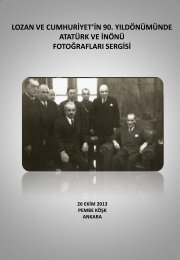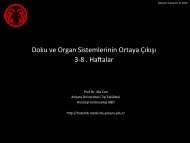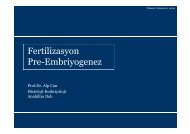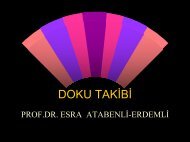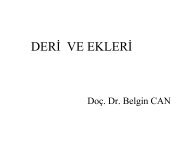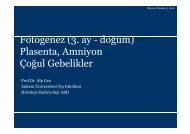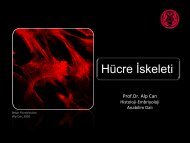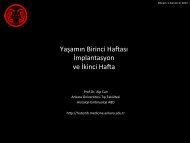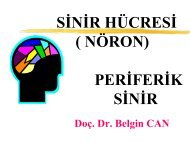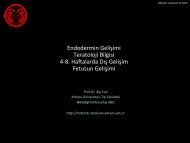dosya indir - ankaratiphastaneleri
dosya indir - ankaratiphastaneleri
dosya indir - ankaratiphastaneleri
Create successful ePaper yourself
Turn your PDF publications into a flip-book with our unique Google optimized e-Paper software.
Avrupa Resüsitasyon Konseyi 2005 Resüsitasyon K›lavuzu<br />
S165<br />
156. Leatherman JW, McArthur C, Shapiro RS. Effect of prolongation<br />
of expiratory time on dynamic hyperinflation in mechanically<br />
ventilated patients with severe asthma. Crit Care Med<br />
2004; 32:1542-5.<br />
157. Bowman FP, Menegazzi JJ, Check BD, Duckett TM. Lower<br />
esophageal sphincter pressure during prolonged cardiac arrest<br />
and resuscitation. Ann Emerg Med 1995; 26:216-9.<br />
158. Lapinsky SE, Leung RS. Auto-PEEP and electromechanical dissociation.<br />
N Engl J Med 1996; 335:674.<br />
159. Rogers PL, Schlichtig R, Miro A, Pinsky M. Auto-PEEP during<br />
CPR. An "occult" cause of electromechanical dissociation?<br />
Chest 1991; 99:492-3.<br />
160. Rosengarten PL, Tuxen DV, Dziukas L, Scheinkestel C, Merrett<br />
K, Bowes G. Circulatory arrest induced by intermittent positive<br />
pressure ventilation in a patient with severe asthma. Anaesth<br />
Intensive Care 1991; 19:118-21.<br />
161. Sprung J, Hunter K, Barnas GM, Bourke DL. Abdominal distention<br />
is not always a sign of esophageal intubation: cardiac arrest<br />
due to "auto-PEEP". Anesth Analg 1994; 78:801-4.<br />
162. Deakin CD, McLaren RM, Petley GW, Clewlow F, Dalrymple-<br />
Hay MJ. Effects of positive end-expiratory pressure on transthoracic<br />
impedance-- implications for defibrillation. Resuscitation<br />
1998; 37:9-12.<br />
163. Mazzeo AT, Spada A, Pratico C, Lucanto T, Santamaria LB.<br />
Hypercapnia: what is the limit in paediatric patients? A case of<br />
near-fatal asthma successfully treated by multipharmacological<br />
approach. Paediatr Anaesth 2004; 14:596-603.<br />
164. Mertes PM, Laxenaire MC, Alla F. Anaphylactic and anaphylactoid<br />
reactions occurring during anesthesia in France in 1999-<br />
2000. Anesthesiology 2003; 99:536-45.<br />
165. Yunginger JW. Latex allergy in the workplace: an overview of<br />
where we are. Ann Allergy Asthma Immunol 1999; 83:630-3.<br />
166. Dreyfus DH, Fraser B, Randolph CC. Anaphylaxis to latex in patients<br />
without identified risk factors for latex allergy. Conn Med<br />
2004; 68:217-22.<br />
167. Ownby DR. A history of latex allergy. J Allergy Clin Immunol<br />
2002; 110:S27-32.<br />
168. Pumphrey RS. Lessons for management of anaphylaxis from a<br />
study of fatal reactions. Clin Exp Allergy 2000; 30:1144-50.<br />
169. Pumphrey RS. Fatal anaphylaxis in the UK, 1992-2001. Novartis<br />
Found Symp 2004; 257:116-28; discussion 28-32, 57-60,<br />
276-85.<br />
170. Incorvaia C, Senna G, Mauro M, et al. Prevalence of allergic reactions<br />
to Hymenoptera stings in northern Italy. Allerg Immunol<br />
(Paris) 2004; 36:372-4.<br />
171. Pumphrey RS, Roberts IS. Postmortem findings after fatal<br />
anaphylactic reactions. J Clin Pathol 2000; 53:273-6.<br />
172. Mullins RJ. Anaphylaxis: risk factors for recurrence. Clin Exp Allergy<br />
2003; 33:1033-40.<br />
173. Brown AF. Anaphylaxis: quintessence, quarrels, and quandaries.<br />
Emerg Med J 2001; 18:328.<br />
174. Brown AF. Anaphylaxis gets the adrenaline going. Emerg Med<br />
J 2004; 21:128-9.<br />
175. Ishoo E, Shah UK, Grillone GA, Stram JR, Fuleihan NS. Predicting<br />
airway risk in angioedema: staging system based on presentation.<br />
Otolaryngol Head Neck Surg 1999; 121:263-8.<br />
176. Pumphrey R. Anaphylaxis: can we tell who is at risk of a fatal<br />
reaction? Curr Opin Allergy Clin Immunol 2004; 4:285-90.<br />
177. Simons FE, Gu X, Simons KJ. Epinephrine absorption in adults:<br />
intramuscular versus subcutaneous injection. J Allergy Clin Immunol<br />
2001; 108:871-3.<br />
178. Simons FER, Chan ES, Gu X, Simons KJ. Epinephrine for the<br />
out-of-hospital (first-aid) treatment of anaphylaxis in infants: Is<br />
the ampule/syringe/needle method practical? Journal of Allergy<br />
and Clinical Immunology 2001; 108:1040-4.<br />
179. Winbery SL, Lieberman PL. Histamine and antihistamines in<br />
anaphylaxis. Clin Allergy Immunol 2002; 17:287-317.<br />
180. Kill C, Wranze E, Wulf H. Successful treatment of severe<br />
anaphylactic shock with vasopressin. Two case reports. Int<br />
Arch Allergy Immunol 2004; 134:260-1.<br />
181. Williams SR, Denault AY, Pellerin M, Martineau R. Vasopressin<br />
for treatment of shock following aprotinin administration. Can<br />
J Anaesth 2004; 51:169-72.<br />
182. Visscher PK, Vetter RS, Camazine S. Removing bee stings. Lancet<br />
1996; 348:301-2.<br />
183. Yocum MW, Butterfield JH, Klein JS, Volcheck GW, Schroeder<br />
DR, Silverstein MD. Epidemiology of anaphylaxis in Olmsted<br />
County: a population-based study. J Allergy Clin Immunol<br />
1999; 104(pt 1):452-6.<br />
184. Ellis AK, Day JH. Diagnosis and management of anaphylaxis.<br />
CMAJ 2003; 169:307-11.<br />
185. Smith PL, Kagey-Sobotka A, Bleecker ER, et al. Physiologic<br />
manifestations of human anaphylaxis. J Clin Invest 1980;<br />
66:1072-80.<br />
186. Stark BJ, Sullivan TJ. Biphasic and protracted anaphylaxis. J Allergy<br />
Clin Immunol 1986; 78:76-83.<br />
187. Brazil E, MacNamara AF. "Not so immediate" hypersensitivity:<br />
the danger of biphasic anaphylactic reactions. J Accid Emerg<br />
Med 1998; 15:252-3.<br />
188. Brady WJ, Jr., Luber S, Carter CT, Guertler A, Lindbeck G. Multiphasic<br />
anaphylaxis: an uncommon event in the emergency<br />
department. Acad Emerg Med 1997; 4:193-7.<br />
189. Joint Working Party of the Association of Anaesthetists of Great<br />
Britain and Ireland and the British Society for Allergy and Clinical<br />
Immunology. Suspected anaphylactic reactions associated<br />
with anaesthesia. 3rd ed. London, The Association of Anaesthetists<br />
of Great Britain and Ireland and British Society for Allergy<br />
and Clinical Immunology, 2003.<br />
190. Payne V, Kam PC. Mast cell tryptase: a review of its physiology<br />
and clinical significance. Anaesthesia 2004; 59:695-703.<br />
191. Anthi A, Tzelepis GE, Alivizatos P, Michalis A, Palatianos GM,<br />
Geroulanos S. Unexpected cardiac arrest after cardiac surgery:<br />
Incidence, predisposing causes, and outcome of open chest<br />
cardiopulmonary resuscitation. Chest 1998; 113:15-9.<br />
192. Wahba A, Gotz W, Birnbaum DE. Outcome of cardiopulmonary<br />
resuscitation following open heart surgery. Scandinavian<br />
Cardiovascular Journal 1997; 31:147-9.<br />
193. Rhodes JF, Blaufox AD, Seiden HS, et al. Cardiac arrest in infants<br />
after congenital heart surgery. Circulation 1999;<br />
100:II194-9.<br />
194. Dimopoulou I, Anthi A, Michalis A, Tzelepis GE. Functional<br />
status and quality of life in long-term survivors of cardiac arrest<br />
after cardiac surgery. Crit Care Med 2001; 29:1408-11.<br />
195. Mackay JH, Powell SJ, Osgathorp J, Rozario CJ. Six-year prospective<br />
audit of chest reopening after cardiac arrest. Eur J Cardiothorac<br />
Surg 2002; 22:421-5.<br />
196. Pottle A, Bullock I, Thomas J, Scott L. Survival to discharge following<br />
Open Chest Cardiac Compression (OCCC). A 4-year<br />
retrospective audit in a cardiothoracic specialist centre - Royal<br />
Brompton and Harefield NHS Trust, United Kingdom. Resuscitation<br />
2002; 52:269-72.<br />
197. Raman J, Saldanha RF, Branch JM, et al. Open cardiac compression<br />
in the postoperative cardiac intensive care unit. Anaesth<br />
Intensive Care 1989; 17:129-35.<br />
198. Birdi I, Chaudhuri N, Lenthall K, Reddy S, Nashef SA. Emergency<br />
reinstitution of cardiopulmonary bypass following cardiac<br />
surgery: outcome justifies the cost. Eur J Cardiothorac Surg<br />
2000; 17:743-6.<br />
199. Rousou JA, Engelman RM, Flack JE, 3rd, Deaton DW, Owen<br />
SG. Emergency cardiopulmonary bypass in the cardiac surgical<br />
unit can be a lifesaving measure in postoperative cardiac arrest.<br />
Circulation 1994; 90:I-I280-4.<br />
200. Schwarz B, Bowdle TA, Jett GK, et al. Biphasic shocks compared<br />
with monophasic damped sine wave shocks for direct ventricular<br />
defibrillation during open heart surgery. Anesthesiology<br />
2003; 98:1063-9.<br />
201. Rosemurgy AS, Norris PA, Olson SM, Hurst JM, Albrink MH.<br />
Prehospital traumatic cardiac arrest: the cost of futility. J Trauma<br />
1993; 35:468-73.<br />
202. Battistella FD, Nugent W, Owings JT, Anderson JT. Field triage



